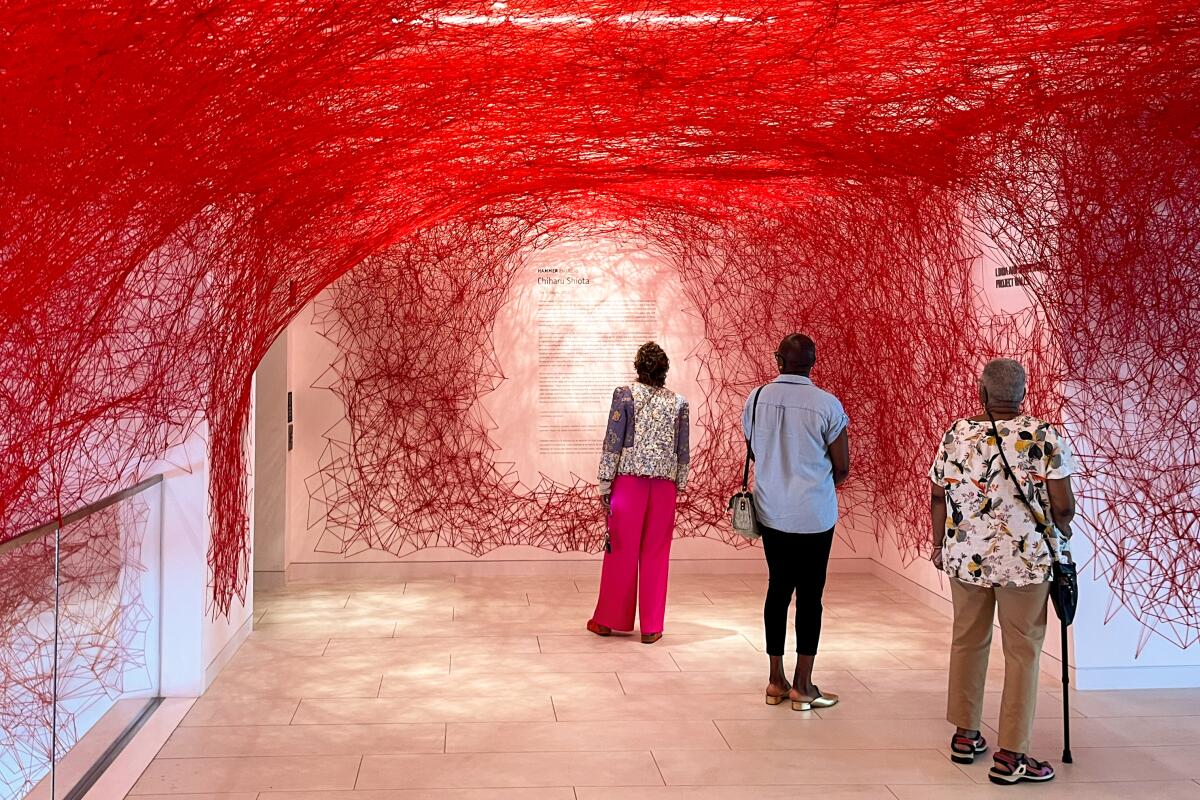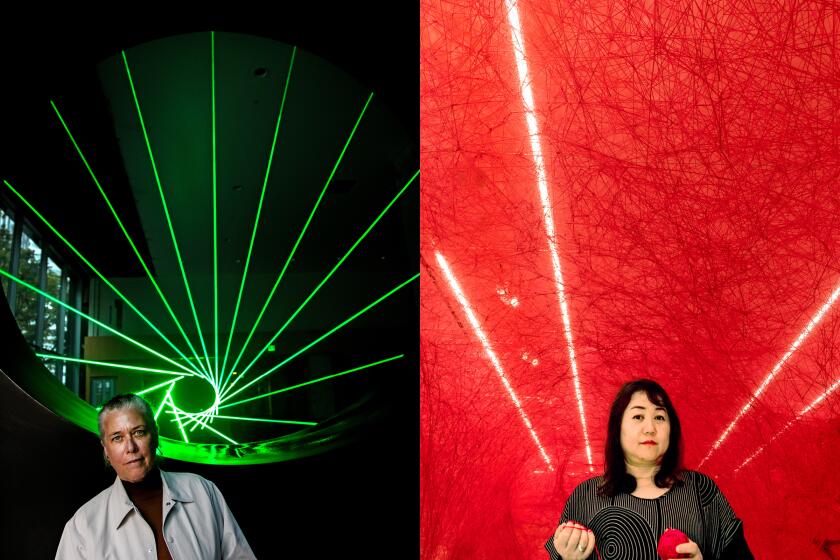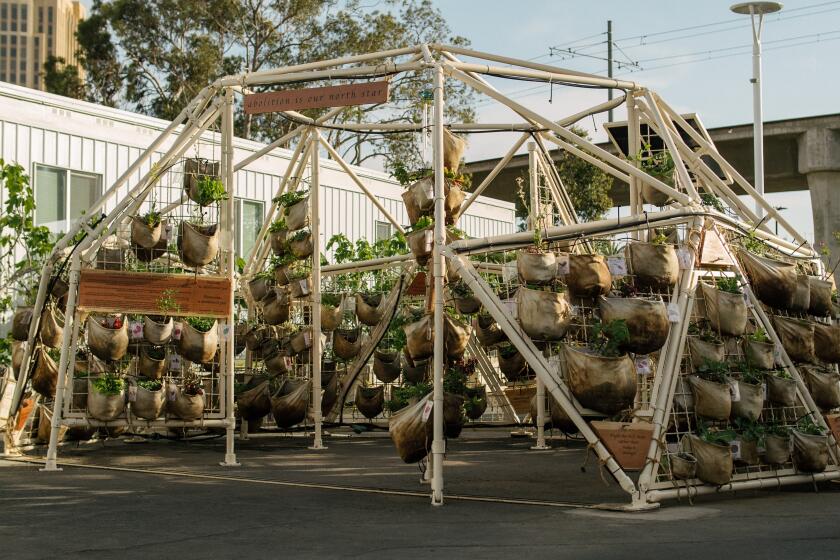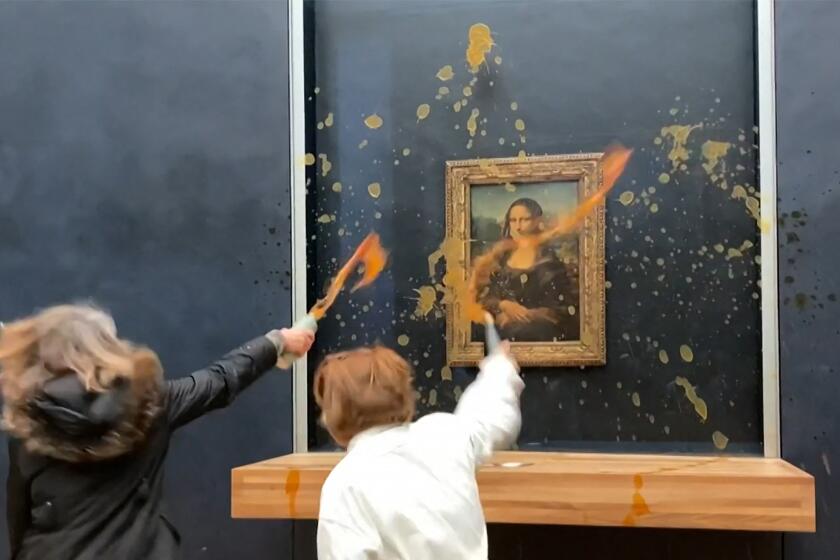The temperature inside these L.A. museums is changing. Why that’s a win for climate action

- Share via
Walking into an art museum this summer might not come with the arctic blast of air conditioning you’re used to feeling — all in the name of environmental consciousness.
The Hammer Museum and the Museum of Contemporary Art in Los Angeles will be among the institutions taking part in the Climate Impact Program launched through PST Art, the Getty’s arts initiative formerly known as Pacific Standard Time.
The program aims to encourage galleries and institutions to minimize their environmental impacts by providing tools to achieve “climate fluency.” Some participating museums are rethinking how they could relax typical climate control standards in exhibition spaces to preserve energy.
Museums have historically maintained strict, narrow ranges of temperatures and relative humidity since the British Museum created the standards around 100 years ago. New research and international art conservation guidelines suggest that a wider range of climate controls can be safe for artwork and would significantly cut energy use, according to climate and art consultant Laura Lupton.
Her firm, LHL Consulting, is leading the Climate Impact Program. Because museums’ exhibition spaces are often cavernous, she said, climate control becomes one of the key areas for reducing energy use and its related carbon emissions.
At MOCA in downtown L.A., baseline emissions are equivalent to the energy use of 20 homes, per the museum’s 2023 sustainability report. With a new energy management system to control HVAC systems, the museum could cut energy usage by 25%.
The Hammer will pilot the expanded temperature and humidity ranges in the PST exhibition “Breath(e): Toward Climate and Social Justice,” which opens in late summer and will feature the work of more than 20 commissioned artists.
“The energy that we use to run the building is a really large portion of every project’s footprint,” said Michael Nock, the director of exhibitions and publication management at the museum. “I can’t thank the artists who are in the show enough for being advocates for it and happy to sign on and endorse the effort.”
The Hammer Museum is debuting large-scale immersive installations in its lobby and new gallery by artists Chiharu Shiota and Rita McBride to mark the completion of its new building project.
Nock said the Hammer can establish these new temperature and humidity levels because the art on display is contemporary and because each artist agreed to the conditions. “We’re not trying to display something that’s really delicate, like panel paintings from 500 years ago,” he said.
MOCA also will be experimenting with its energy use beyond the installation of its new HVAC systems. In its PST Art exhibition, a new site-specific installation by artist Olafur Eliasson at the museum’s Geffen Contemporary space in Little Tokyo, the museum is expanding its range to plus or minus 5 degrees from a set point of 70.
This range is in alignment with guidelines in protocols from the Bizot group, which consists of leaders from some of the world’s largest museums and art institutions. Kelsey Shell, the environmental and sustainability strategist at MOCA, said the museum was eager to respond to the “urgent” call for museums to adopt environmentally sustainable approaches.
“It’s difficult for any institution to be the first,” Shell said. “This is an example where the Climate Impact Program and the discussions with colleagues that have come from that have allowed more institutions to feel safer in making those choices together.”
MOCA and the Hammer are in the company of dozens of institutions taking part in PST Art, which will launch in September with the theme “Art and Science Collide.” Once the Getty decided on the theme and began discussions with art and science institutions across Southern California about two years ago, an overwhelming number of them wanted to tackle the climate crisis, according to Joan Weinstein, director of the Getty Foundation.
Getty’s PST Art collaboration (previously known as Pacific Standard Time) is set to open next fall with a vast array of public programming set to examine the intersection of art and science.
Creating a formal way for these institutions to integrate climate-based decision making throughout their operations, from the temperature of their facilities to the content of their exhibitions, felt like a natural next step, Weinstein said.
“If each individual institution had to undergo this learning process all on their own, it would be really challenging,” Weinstein said. “Doing it as a community sharing all those resources, sharing the knowledge that already existed in the community has so much more impact.”
Participating institutions may repurpose materials, encourage artists to craft installations on-site to avoid transportation-related emissions, and even look into using sustainable paper for programs and brochures.
Other participants include the Skirball Cultural Center, the Broad, the California African American Museum and La Brea Tar Pits.
Extreme acts such as hurling food at masterpieces of art make less aggressive tactics more palatable for others to engage in.
Lupton, who developed the Climate Impact Program after focusing on sustainability in the art world for about a decade, said the role museums can play in climate action is substantial and often overlooked.
“Museums are the most trusted institutions, full stop,” Lupton said. “Being seen as institutions that are actually taking responsibility in making sure that museums are a climate solution inherently helps build a sense of community trust.”
These institutions are also hoping to explore climate in ways that encourage museum-goers to think about solutions as achievable as taking a closer look at their home thermostat.
“In dealing with the climate crisis, having all those facts and figures and charts become overwhelming for people,” Weinstein said. “Artists can sometimes break through that in their work and see new possibilities, see new hope for action, and I think that’s what some of these exhibitions will deliver.”
More to Read
The biggest entertainment stories
Get our big stories about Hollywood, film, television, music, arts, culture and more right in your inbox as soon as they publish.
You may occasionally receive promotional content from the Los Angeles Times.














